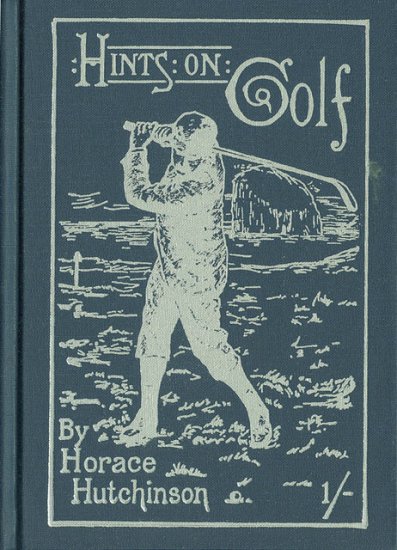Hints on the Game of Golf (1886)
$50.00
By Horace Hutchinson
Foreword by Herb Wind, Afterword by Jack Nicklaus
This is a seminal book in the library of golf, being the first mass-produced book of instruction. In spite of its diminutive size, Hints on the Game of Golf was such a revelation to the uninitiated and aspiring players that it was an immediate success. Nor was the success short-lived, as the book was in print for 20 years through 14 printings. This is the author’s first work and a watershed volume in golf literature. The attraction of this century old book is not the technical instruction; the long nose clubs of that era required a much different swing than we need with today’s modern equipment. Its fascination is that Hutchinson saw the need for such a book and that the result is engaging still today.
This is not a dry, club-by-club instructional like so many modern offerings. Spirited and informal, it is part description, part admonishment, part scientific treatise, and part recitation of the truisms from the ancient game. Hutchinson actually cites himself as having often said golf could not be taught successfully through a book, but he explains his reversal in the introduction. Hutchinson wrote this book partly out of frustration at seeing men playing golf “in a style in which it is physically, anatomically, mathematically, from very conceivable point of view, impossible for a human being, made on any known plan, to strike the ball correctly.”
This is another ‘must have’ book.
Description
By Horace Hutchinson
This is a seminal book in the library of golf, being the first mass-produced book of instruction. In spite of its diminutive size, Hints on the Game of Golf was such a revelation to the uninitiated and aspiring players that it was an immediate success. Nor was the success short-lived, as the book was in print for 20 years through 14 printings. This is the author’s first work and a watershed volume in golf literature. The attraction of this century old book is not the technical instruction; the long nose clubs of that era required a much different swing than we need with today’s modern equipment. Its fascination is that Hutchinson saw the need for such a book and that the result is engaging still today.
This is not a dry, club-by-club instructional like so many modern offerings. Spirited and informal, it is part description, part admonishment, part scientific treatise, and part recitation of the truisms from the ancient game. Hutchinson actually cites himself as having often said golf could not be taught successfully through a book, but he explains his reversal in the introduction. Hutchinson wrote this book partly out of frustration at seeing men playing golf “in a style in which it is physically, anatomically, mathematically, from very conceivable point of view, impossible for a human being, made on any known plan, to strike the ball correctly.”
The advice to beginners in the first section is rudimentary, but Hutchinson’s uncanny identification of the core requirements for a good strike of the ball is absorbing. He succeeds in the literary challenge of focusing the tyro’s attention on the basic mechanics while framing the game in its fullest context to the uninformed. The second half offers hints to the established player, many non-technical in nature:
“If your adversary is badly bunkered, there is no rule against your standing over him and counting his strokes aloud, with increasing gusto as their number mounts up; but it will be a wise precaution to arm yourself with a niblick before doing so, so as to meet him on equal terms.”
The final section, “The Miseries of Golf”, offers Hutchinson some ironic relief after pages of teaching the incommunicable, perhaps to the non-teachable. He cautions the novice of the beguiling nature of golf and warns of the woes that eventually befall all golfers. How the one time you decide to practice before an event, is the time you will break your favorite, most often-used club. How embarrassing it is to declare a lost ball, only to have someone find it on the precise line you looked over, but 60-yards nearer the tee. How after you buy an expensive club, you are likely to find the shots you play with it are inferior to those you struck before you owned it. Pure misery is the sinking feeling that your partners may think you are a poor player, while knowing they are fully justified, considering your recurrent terrible exhibition. These observations are as much about human nature as they are about golf, giving Hints on the Game of Golf vitality and added meaning. You will find Hutchinson packs a great deal into this small volume, including his final observation on the different facets of the play: “Driving is an Art. Iron play is a Science. Putting is an Inspiration.”
Foreword by Herbert Warren Wind, Afterword by Jack Nicklaus.
(2-book set in slipcase with REMINISCENCES OF GOLF ON ST. ANDREWS LINKS, BY JAMES BALFOUR)
Additional information
| Weight | 3 lbs |
|---|

